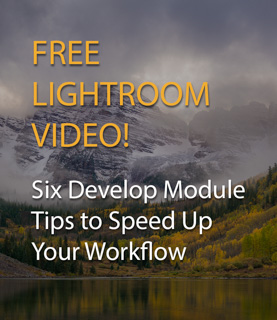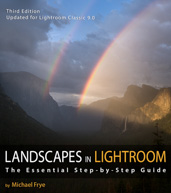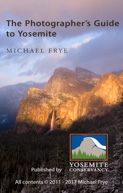In the Moment:
Michael Frye's Landscape Photography Blog
by Michael Frye | Dec 19, 2011 | Announcements, Yosemite Photo Conditions
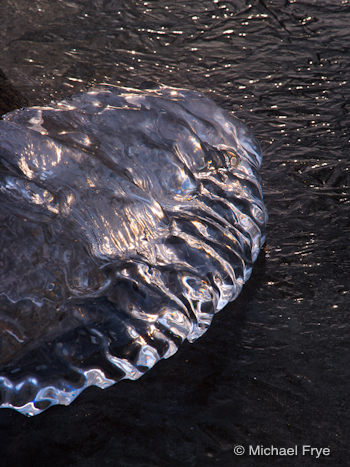
Ice mollusk, Tenaya Lake
If you’ve been wondering if I’ll ever do another photo critique, the answer is yes—look for one tomorrow. Sorry it’s been so long, but it’s just been a crazy busy fall!
In other news, both the Tioga and Glacier Point roads in Yosemite are open. This is rare for December, but the weather has been so dry and mild that there’s little snow up in the high country.
Any unusual conditions bring interesting photo opportunities, and the cold temperatures combined with lack of snow means that there are some great ice formations along the Tioga Road, like this natural ice sculpture I photographed at Tenaya Lake about 10 days ago.
Also, I hear there’s some great ice skating up there on Tenaya, Tioga, and Ellery Lakes! There’s no sign of snow in the forecast, so these roads should stay open for at least another week.
Another item: congratulations to friends of this blog David Hoffman, Jon McCormack, William Neill, Penny Otwell, and Greg Russell for having their work accepted into the 27th annual Yosemite Renaissance exhibit. It’s nice to be in such good company! And an extra congratulations to Jon, who won a “Commended” award in the prestigious Travel Photographer of the Year competition. Great stuff Jon!
And another thing… the end of the year is approaching, so once again I’ll be asking for your help in choosing my best images of the year. Look for something within the next couple of weeks.
I hope you’re enjoying the holiday season, and not rushing around too much getting ready!
by Michael Frye | Dec 15, 2011 | Announcements, Workshops
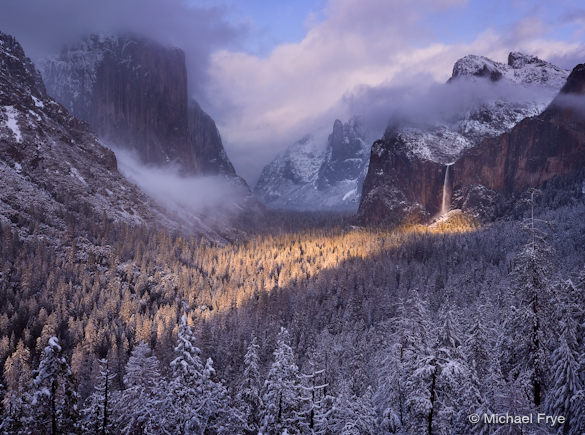
Spotlight on Bridalveil Fall
Just a quick note to let you know that, due to a cancellation, there’s one space available in my Landscapes in the Digital Darkroom: Mastering Lightroom workshop, January 16-20, 2012. And since it’s in January, it should be no problem to get a hotel room this late—and at off-season rates! Click here to register and grab that last space.
Meanwhile, my Spring Digital Camera workshop is full, and the Eastern Sierra Fall Color workshop filled within a few days. But there’s still space left in the Hidden Yosemite (July), Full Moon Night Photography (July-August), and Digital Landscape (October) workshops.
—Michael Frye
Related Posts: 2012 Workshops Announced; Two New Workshops for 2012
Michael Frye is a professional photographer specializing in landscapes and nature. He is the author and photographer of The Photographer’s Guide to Yosemite, Yosemite Meditations, and Digital Landscape Photography: In the Footsteps of Ansel Adams and the Great Masters, plus the eBook Light & Land: Landscapes in the Digital Darkroom. He has written numerous magazine articles on the art and technique of photography, and his images have been published in over thirty countries around the world. Michael has lived either in or near Yosemite National Park since 1983, currently residing just outside the park in Mariposa, California.
by Michael Frye | Dec 14, 2011 | Advanced Techniques
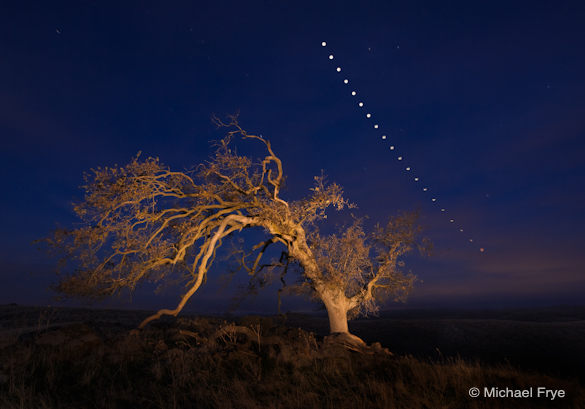
Oak tree and lunar eclipse sequence, December 10th, 2011
For me the hardest part about photographing last Saturday morning’s lunar eclipse was finding a good location. The fully-eclipsed moon would be close to the horizon in the west-northwest, so I needed a clear view in that direction, ideally with an interesting object in the foreground.
No place in Yosemite seemed to fit—too many mountains in the way. But I thought a remote region of western Mariposa County, with rolling hills and scattered oaks, might work. A week before the eclipse I scouted this area and found a photogenic oak tree on top of hill that seemed to line up with the projected path of the eclipse.
Friday night my student Erik and I got a couple hours of sleep, drove out to this spot, hiked up the hill, set up our cameras, and started our interval timers to capture a sequence of moon images ten minutes apart. We had a long wait, but it wasn’t too cold, and we enjoyed our peaceful, moonlit surroundings. A pair of great-horned owls serenaded us, and groups of coyotes howled at regular intervals. At one point Erik watched four coyotes climb a nearby moonlit hill, then saw one of them stop and howl.
(more…)
by Michael Frye | Dec 7, 2011 | Announcements, Reviews
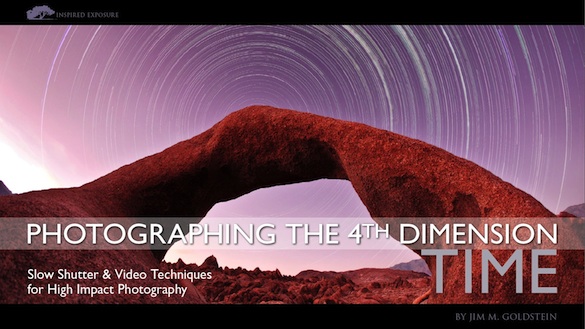
Jim Goldstein has just released a new eBook called Photographing the 4th Dimension – Time. In the book Jim describes seven different slow shutter speed and video techniques for making more creative photographs—including long exposures, light-painting, star trails, time-lapse, and cinemagraphs.
This book is a great way to delve into some new, fun, and creative aspects of photography. If you’ve never tried photographing star trails, making time-lapse videos, or creating cinemagraphs, Jim makes it easy to get started by giving you step-by-step instructions, sometimes including video tutorials.
Just browsing through the book can inspire you to try some new techniques and give your photography a creative kick in the pants. Personally I was intrigued by the cinemagraphs, where part of a still photograph is animated. Some cinemagraphs I’d seen before looked rather cheesy, but after viewing some of the examples here I realize that they can be done subtly, and beautifully, so I’m eager to try them—and it’s nice to have Jim’s detailed instructions for doing so.
(more…)
by Michael Frye | Dec 5, 2011 | Advanced Techniques, Photography Tips
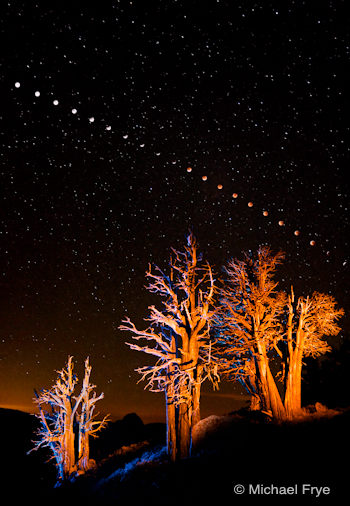
Lunar Eclipse Sequence, 1:23 a.m. to 4:49 a.m., August 28, 2007
Before getting to the topic at hand, I want to let you know that eight people have signed up for the Eastern Sierra Fall Color Workshop since I announced it last Thursday. The limit is twelve students, and I’m sure it will fill up soon, so if you’re thinking about signing up don’t procrastinate!
Okay, on to the eclipse. Before dawn this Saturday, December 10th, viewers in the Western U.S. and Canada will be able to see a total lunar eclipse. If you live in the eastern half of the U.S. unfortunately you’ll only be able to see a partial eclipse. People in most of Europe, Asia, and Australia will also be able to see a total eclipse, though in Europe it will be visible at moonrise on Saturday evening. This NASA page shows where the eclipse will be visible throughout the world, and this page shows more detail for western North America.
Moon Position
If the weather cooperates, and you want to try make your own eclipse photographs, here are some tips. (I’ve copied some of this from my post a year ago, but the information about the moon position is all new.)
(more…)






